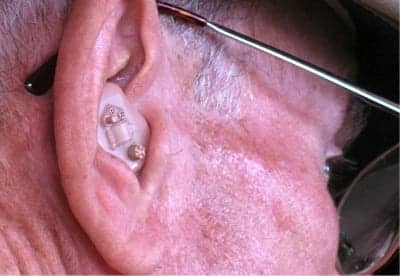A new software product developed by researchers at the University of Cambridge could greatly improve sound perception for users of hearing aids.
The software prescribes the amount of amplification of high-frequency sounds required to restore the audibility of such sounds. This increases the frequency range of sound that individuals with hearing loss 
Hearing loss typically occurs at high frequencies, and individuals with hearing loss can only hear comfortably within a small intensity range at those frequencies. While the threshold for detecting a certain sound may be higher for someone with hearing loss, the level at which sound is uncomfortably loud is often similar for individuals with hearing loss and those with normal hearing. To deal with this problem, hearing aids split sound into large numbers of frequency channels, or bands. Within each band, weak sounds are amplified while strong sounds are not. This is called multi-channel automatic gain control.
Researchers at the University of Cambridge have developed CAM2, a new method of fitting automatic gain control based on the audiogram of the user. An audiogram shows an individual’s threshold for detecting sound at different frequencies.
“Until recently, hearing aids only provided amplification for frequencies up to 4 or 5 kHz, whereas a person with normal hearing can hear for frequencies up to 15 or 20 kHz,” said Professor Brian Moore of the university’s department of psychology, who led the development of CAM2. “Manufacturers have recently released hearing aids that can amplify frequencies up to 8 or 10 kHz, but existing fitting methods do not give any recommendations for those higher frequencies.” The CAM2 method, however, extends the fitting range up to 10 kHz.
Higher frequencies help distinguish sounds such as “sh”, “ch” and “f”. In challenging listening situations, such as in a room where several people are speaking at once, the higher frequencies make it much easier to understand the person you want to listen to. The higher frequencies can also improve sound localization, making it easier to identify where a particular sound is coming from.
A recent study compared the CAM2 method with NAL-NL2, which is one of the most widely used fitting method today. Judgments of overall sound quality were obtained for male and female speech in both quiet and noisy environments, and for four different types of music (classical, jazz, a man singing and percussion). Most participants in the study showed a preference for CAM2, both for overall sound quality and for the clarity of speech in a noisy situation. Further studies are planned over the coming months, in order to test more subjects with a wider range of hearing loss.
The CAM2 software is being commercialized by Cambridge Enterprise, the University’s commercialization group.
SOURCE: The University of Cambridge





